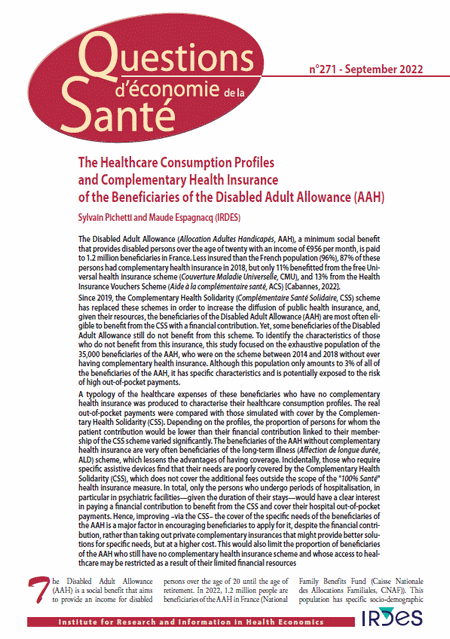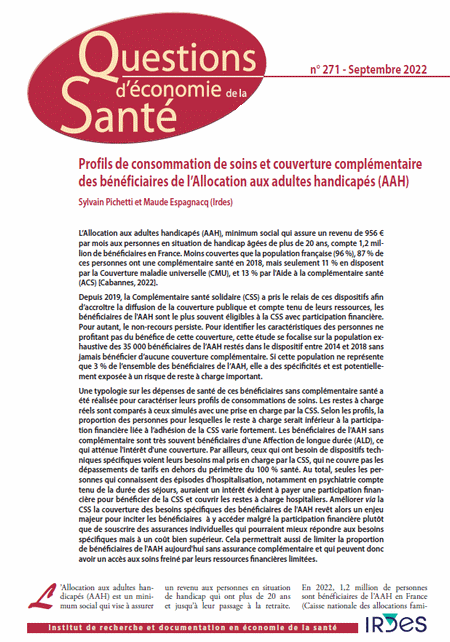The Healthcare Consumption Profiles and Complementary Health Insurance of the Beneficiaries of the Disabled Adult Allowance (AAH)
Pichetti S. (IRDES), Espagnacq M. (IRDES)
Questions d'économie de la santé (Issues in Health Economics) n° 271 - September 2022
ABSTRACT
The Disabled Adult Allowance (Allocation Adultes Handicapés, AAH), a minimum social benefit that provides disabled persons over the age of twenty with an income of €956 per month, is paid to 1.2 million beneficiaries in France. Less insured than the French population (96%), 87% of these persons had complementary health insurance in 2018, but only 11% benefitted from the free Universal health insurance scheme (Couverture Maladie Universelle, CMU), and 13% from the Health Insurance Vouchers Scheme (Aide à la complémentaire santé, ACS) [Cabannes, 2022].
Since 2019, the Complementary Health Solidarity (Complémentaire Santé Solidaire, CSS) scheme has replaced these schemes in order to increase the diffusion of public health insurance, and, given their resources, the beneficiaries of the Disabled Adult Allowance (AAH) are most often eligible to benefit from the CSS with a financial contribution. Yet, some beneficiaries of the Disabled Adult Allowance still do not benefit from this scheme. To identify the characteristics of those who do not benefit from this insurance, this study focused on the exhaustive population of the 35,000 beneficiaries of the AAH, who were on the scheme between 2014 and 2018 without ever having complementary health insurance. Although this population only amounts to 3% of all of the beneficiaries of the AAH, it has specific characteristics and is potentially exposed to the risk of high out-of-pocket payments.
A typology of the healthcare expenses of these beneficiaries who have no complementary health insurance was produced to characterise their healthcare consumption profiles. The real out-of-pocket payments were compared with those simulated with cover by the Complementary Health Solidarity (CSS). Depending on the profiles, the proportion of persons for whom the patient contribution would be lower than their financial contribution linked to their membership of the CSS scheme varied significantly. The beneficiaries of the AAH without complementary health insurance are very often beneficiaries of the long-term illness (Affection de longue durée, ALD) scheme, which lessens the advantages of having coverage. Incidentally, those who require specific assistive devices find that their needs are poorly covered by the Complementary Health Solidarity (CSS), which does not cover the additional fees outside the scope of the "100% Santé" health insurance measure. In total, only the persons who undergo periods of hospitalisation, in particular in psychiatric facilities -given the duration of their stays- would have a clear interest in paying a financial contribution to benefit from the CSS and cover their hospital out-of-pocket payments. Hence, improving -via the CSS- the cover of the specific needs of the beneficiaries of the AAH is a major factor in encouraging beneficiaries to apply for it, despite the financial contribution, rather than taking out private complementary insurances that might provide better solutions for specific needs, but at a higher cost. This would also limit the proportion of beneficiaries of the AAH who still have no complementary health insurance scheme and whose access to healthcare may be restricted as a result of their limited financial resources.
See also Questions d'économie de la santé n° 271 in French: Profils de consommation de soins et couverture complémentaire des bénéficiaires de l'Allocation aux adultes handicapés (AAH).
See also Podcast n° 4 in French: Aides auditives et 100 % santé : les enjeux d'une réforme très française.

